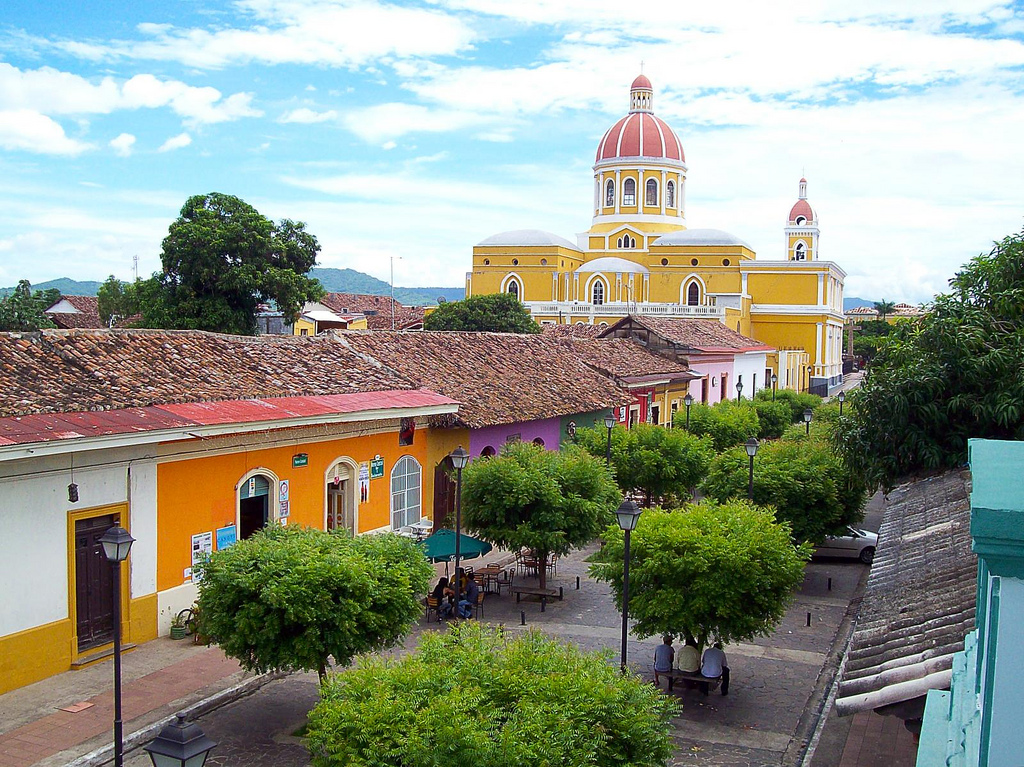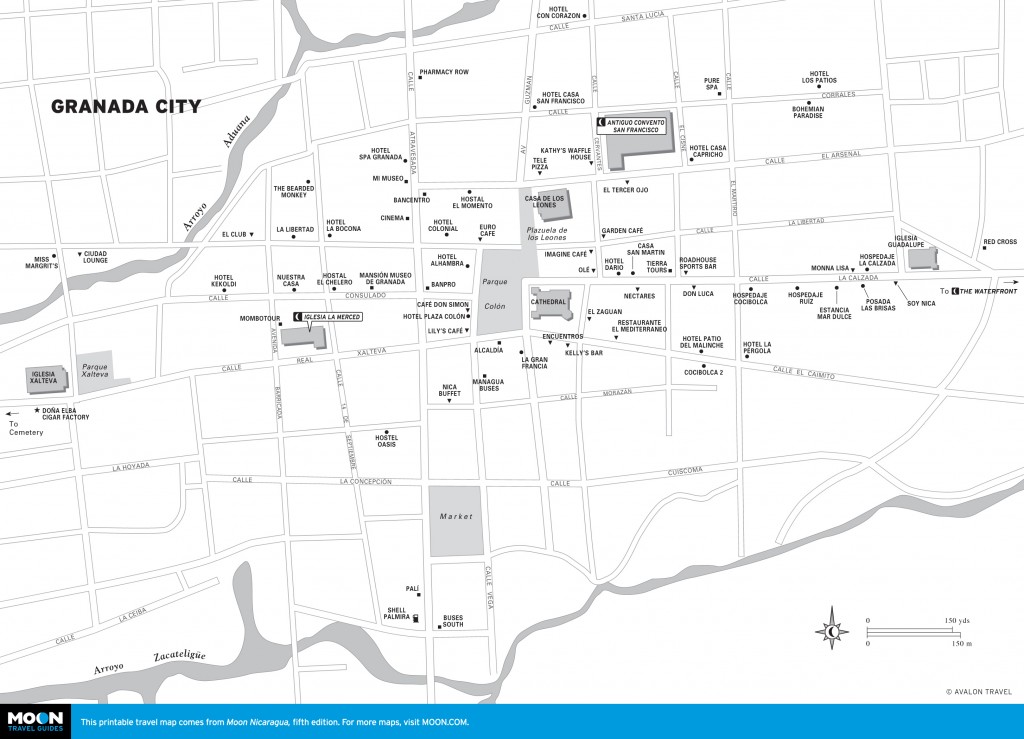Arguably Nicaragua’s most picturesque town, Granada is an easy place to love. Much of its colonial architecture is remarkably intact and is being painstakingly restored by a new generation of homeowners. The colorful facades lining old narrow streets practically glow in the late afternoon sun. It’s sultry and tropical here, but a fresh breeze blows off the waters of Lake Cocibolca. The views from along the lakeshore’s broad, undeveloped shoreline—and the ever-looming silhouette of Volcán Mombacho—make for easy photos and good memories.

View from a hotel balcony in Granada. Photo © Adalberto H. Vega, licensed Creative Commons Attribution.
While Granada lacks the five-star luxury or business hotels of the capital and coast, it instead offers a wide selection of small, charming guesthouses, bed-and-breakfasts, and colonial lodges.Granada has always been important politically for Nicaragua, and it is the home of many of the country’s economic and political elite. Most travelers eschew Managua and flock to Granada because of its charm and lethargic pace, making it their base for further exploration. Some decide to stay, as evidenced by the many real estate offices that have sprung up over the last decade.Granada is pleasant to explore by foot or old-fashioned horse carriage. In the evening, the sky fills with stars and neighbors come out to chitchat on their front stoops; inside, even the most nondescript colonial facade is an open, private courtyard designed to capture the evening breeze. Granada’s restaurants are varied and high quality, offering something for just about everybody. While Granada lacks the five-star luxury or business hotels of the capital and coast, it instead offers a wide selection of small, charming guesthouses, bed-and-breakfasts, and colonial lodges.
Lying in close proximity to the chaotic capital, Granada is an undeniably more attractive jumping off point for southern destinations. From here, there are direct ferries to La Isla de Ometepe. Carrying on south along the Pan-American Highway will lead you directly to the city of Rivas—with further transport options for Ometepe—and the surf-dominated coastline from San Juan del Sur to Popoyo. To the east, the crafts and folklore of Masaya are easily reached in under 30 minutes, while the capital itself is less than an hour away. If the large businesses and the international airport aren’t keeping you in Managua, Granada is a handsome alternative hub for travel within the country.
Granada has a history as long as colonial Nicaragua’s, as it is in fact the oldest city in North America. Founded 1524 by Francisco Hernández de Córdoba on the edge of Lake Cocibolca, the Spanish built Granada strategically adjacent to the indigenous community of Xalteva, whose residents suddenly found themselves working for their new foreign “visitors.” Granada grew quickly as a sort of trade hub; sailing vessels would navigate their way up the Río San Juan and across the lake to Granada. As a result, an affluent Spanish merchant class developed, largely of Veracruz, Cartagena, and La Habana origin. From its beginnings, Granada was a symbol of Spanish opulence, an unsubtle show of mercantile success in the New World. The competing nations accepted the challenge, sacking and burning the city at every available opportunity (the English buccaneers were particularly effective).
After independence from Spain, Granada was the capital of Nicaragua each time the Conservatives took power (León was the capital when the Liberals won). As the Liberal- Conservative feud escalated, it was the Liberals who first called upon the American filibuster William Walker for support. He executed Granada’s most ruthless sacking, even by pirate standards. Before he was eventually driven from Granada, he finally burned the whole place to the ground, and buried a symbolic coffin in the central plaza under a wooden sign that read “Aquí Fue Granada” (Here Was Granada).
Despite the sackings and reconstruction, Granada remains little changed from its earliest colonial incarnation; if Córdoba were to rise from the grave today and walk the streets of La Gran Sultana, as it is sometimes called, he would find it eerily familiar. But these days, Granada is changing fast. Less influential than the old families these days is the influx of foreign capital, new ideas, and fast business. A decade ago, Granada was a “sleepy colonial jewel.” The hum of the Internet cafés, chic eateries, tour services, and trendy hotels indicate it has woken up.
From Granada’s central tree-lined plaza, a.k.a. Parque Central and Parque Colón, look south to the giant Volcán Mombacho. Just behind the cathedral on the park’s east side, Calle La Calzada runs due east about one kilometer to the municipal dock on the lake. A lot of the lodging and restaurants lie along this street or within a block or two of it.
At the lake, a paved road runs south along the water’s edge to The Waterfront (malecón), a would-be tourist complex that’s emptier than it should be, but remains a peaceful, wooded lakeshore walking park. An easy taxi ride farther south finds the marinas that provide boat access to the isletas and Zapatera.
West of the plaza is the Xalteva (pronounced more or less with a hard “h”) neighborhood, and eventually the cemetery and road to Nandaime. In this neighborhood, one block west of the Plaza, is Calle Atravesada, running north-south between the old 1886 train station to the bustling chaos of the municipal market. This is one of Granada’s main thoroughfares and a modern commercial center, of sorts, for banks, movie theaters, and the like.
A full day and night in Granada is the minimum and allows you to explore the streets, sleep somewhere interesting, and enjoy a good meal or two. But a lot of Granada’s charm lies in the interesting excursions reachable if you use Granada as a base camp. Leave half a day for a boat ride in Las Isletas and another day for Volcán Mombacho. Most people devote another day for visiting the pueblos and markets in Masaya. While you could conceivably day-trip to the Laguna de Apoyo as well, the hotel options make it a fun place to stay (when was the last time you woke up inside a volcano crater?).

Granada City
Excerpted from the Fifth Edition of Moon Nicaragua.